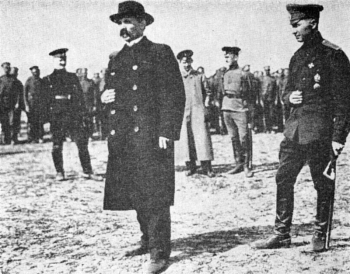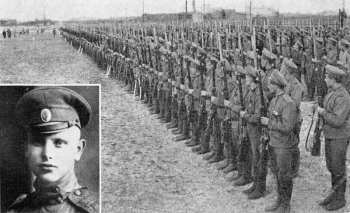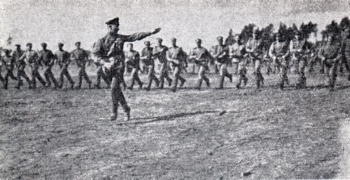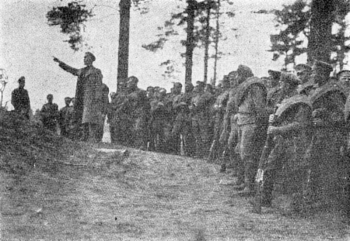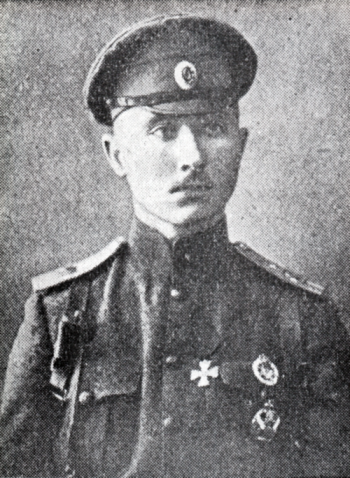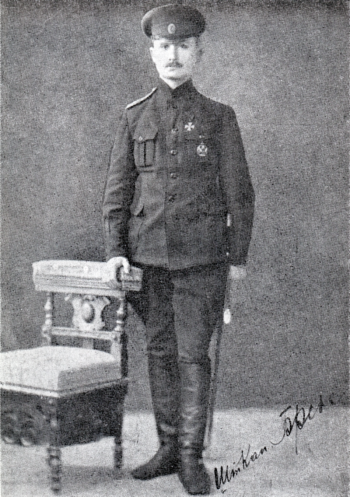2 | The innovator and the man
The foundation of Briedis' tactics may be further examined in other cases. The essence of such tactics was that, if one wanted to surprise the enemy, diligent preparations were necessary. If one wanted to surprise the enemy, nothing was to be gained by warning him by too weak an artillery preparation, as was usual then on the Russian side and could never be sufficiently intensive to prepare the way for the infantryman. Then he tried to approach the enemy 'unwarned', at night; all that was required of the artillery was to interdict the sector being attacked (to prevent reinforcements coming forward or to secure our flanks when the breach had already been made).
He was an innovator in the sense that he was pouring old wine into new
Briedis, of course, needed fighters who could meet the demands made of them. In the battalion journal it can be seen how on 3 September Briedis exchanged 48 under-age youths in his company for adults from the reserve company. It is not clear from the journal whether any other would have done this. Of course, because of a shortage of men not all could do this. G. Krēsliņš (then an instructor in Briedis' company and later an officer in the first regiment) said of the company and Briedis: 'The platoon commanders (sergeants, at that time senior NCOs) were the following: 1st platoon - Grikmanis (St George, 4th cl.); 2nd platoon (where I was) - Junkers, very tall, fearless, also St George 4th cl., they wanted to give him a commission for merit in the field but could not do so, as he could not read. In the 3rd platoon it was Kalniņš (also St George 4th cl.), while in the fourth platoon it was senior sergeant Lauris (likewise St George 4th cl.). The latter was on a reconnaissance mission to Jelgava. He along with several others who were from Rigas Jūrmala had got round the German frontline by taking a fishing boat. They had landed wearing shabby civilian clothes, walked to Jelgava and made their way back after a few weeks. The senior-sergeant of the 1st company was a cadet officer, Āboļkalns (or perhaps Abejkalns), and he too had been awarded the cross of St George 4th class.
'Briedis was of meagre build, slim, of average height (perhaps 165-175 cms), dry, very full of life and active: on patrols he was in the habit of carrying a riding crop. When Briedis walked in front of his company, the company could only follow him at the run. He did not have either a moustache or a beard. He did not suffer from the cold and so wasn't in the habit of wearing a greatcoat, except when on parade when it was obligatory. He usually had on his back a black double-breasted jacket made of skin; on his feet he usually wore felt boots.
Illustrations inset between pages 24 and 25.
'Briedis was warm-hearted, yet never descended to familiarity;
'Briedis discovered various new methods to overcome barbed wire entanglements. Firstly he would try throwing wattle mats over them - but these weren't really effective because the fence posts were not always of the same height. Best of all was to cut through the wire with large shears on both sides of the post and then pull the post itself out of the ground. Two riflemen would go ahead to do the cutting. Hardly had the wire been cut through than it was pulled back and then everybody would silently steal through the gap created. Already on St Martin's Eve (10/23 November) they used white overalls as it had snowed. Some wire entanglements were blown up using reinforced charges of pyroxiline. These were made from from four pieces attached to a board and shoved just below the wire fence. A Bickford cord fuse was attached to the charges which were ignited before the demolition team withdrew about 50 paces. At the moment of the explosion the whole company threw themselves forward at the point where the gap had been torn (the gates were open to a width of 20 feet). To begin with, Briedis' company used these methods on their own. But later other companies also learned them, carrying out training according to Briedis' example. It was even said (I cannot confirm this) that rockets with parachutes had been invented by Briedis, and that the factories were manufacturing them on his instructions. (In reality the mats and the explosive charges too were not Briedis' discoveries - examples of them had even been sent to military units, as well as drawings and dimensions, material instructions, etc.) Briedis' merit was that he tried to test everything assiduously to find which was the most suitable. The mats were of little use and not only because of the unevenness of the posts, while explosives too had serious defects - they immediately drew attention to the true break-in point. Everything depended on what was the most suitable thing to use on each occasion. But what is of significance here is the extent to which Briedis' prestige had grown among his own men. Briedis and Bangerskis (the
One who was longest in the Latvian riflemen along with Briedis was P. Dardzāns. He described Briedis thus: 'Briedis was not a tall man, at any rate below average height - 5'3" - 5'4". His face was oval with a straight well-formed nose, and steel-blue eyes. His walk was light and springy, his movements were rapid, but in a moment of need tightly controlled. His way of extending his arm was out of the ordinary. He did not stretch his arm out straight in front of him, but always kept his elbow pressed to his side. He spoke Latvian with a marked but indefinable accent. It was not Russian or German but perhaps a mixture of the Latvian spoken dialect of his parents and the imprint of the Russian which he had used for many a year in school and during his military service. I couldn't say what form of Latvian dialect his parents spoke: all I know is that Briedis' elder brother, whom I knew personally later, spoke pure Latvian.
'Briedis was very controlled by nature and his voice carried well even though it was low-pitched. All that time from 1915 to 1918, whenever I saw him or met him, I never heard him speak in a sullen raised voice or use rude words. He was always brisk, friendly and optimistic in himself. It is true that he had become a devotee of yoga and, in critical moments as well as in the mornings when he was beginning his walks, he would always spend some time in concentration, turning his thoughts inward.
'One could not say that Briedis was particularly handsome, but a certain sweetness shone through all his being. He was a great success with the ladies for he knew just how to talk to them. Also he liked the company of ladies.
'Briedis took little interest in the economic side of the war but
'I want to draw attention to Briedis' most important quality, his luck! Napoleon said that he did not need marshals who were unlucky. Briedis would certainly have earned his marshal's baton under Napoleon, for everything that he undertook was crowned with success. Leading an army in battle is a very complicated thing. The best plans go awry if there is just 'something' lacking. And this 'something' was the main reason for and the foundation of his success. It can be called a sixth sense or intuition. Briedis was endowed with the sixth sense, and that's why we remember him as a hero and great soldier.
Like all evidence, here too one chances on discrepancies, for example, about his wearing a greatcoat; also as regards his height. As I see him, Briedis seemed to be definitely a man of average height, who completely disappears standing beside Bangerskis, which is in complete agreement with his classification at the military academy. Yet there appear to be fewer differences when comparing notes on Briedis' generally clearly drawn external appearance and - what is the main thing - his personality as a man.
| 1 | Even with the introduction of drabber colours - khaki, feldgrau and horizon blue - officers' uniforms were normally clearly distinguished, and not only by badges of rank, from the uniforms of other ranks; they also usually carried different small arms. It was soon noticed that these differences, however small, made officers a likely target for enemy snipers. There are numerous accounts of warfare on the Western Front which describe officers, before going over the top, putting on other ranks' tunics and carrying rifles instead of pistols and revolvers. This is the first account I have seen on the Eastern Front, though no doubt there are others.—D.G. (original footnote) |
 Gallery
Gallery